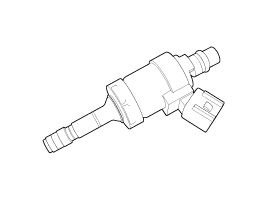Hyundai Genesis (DH): Engine Control System / Injector Description and Operation
Hyundai Genesis (DH) 2013-2016 Service Manual / Engine Control / Fuel System / Engine Control System / Injector Description and Operation
| Description |
Based on information from various sensors, the ECM can
calculate the fuel amount to be injected. The fuel injector is a
solenoid-operated valve and the fuel injection amount is controlled by
length of injection time. The ECM controls each injector by grounding
the control circuit. When the ECM energizes the injector by grounding
the control circuit, the circuit voltage should be low (theoretically
0V) and the fuel is injected. When the ECM de-energizes the injector by
opening control circuit, the fuel injector is closed and circuit voltage
should momentarily reach the peak, and then settle at system voltage.

Inspection 1. Connect the GDS on the Data Link Connector (DLC ). 2. Measure the output voltage of the FTPS. Specification: Refer to "Specification" Removal 1.
Specification ItemSpecificationCoil Resistance (?)0.98 ~ 1.14 [20
Other information:
Hyundai Genesis (DH) 2013-2016 Service Manual: Components and Components Location
C
Hyundai Genesis (DH) 2013-2016 Service Manual: Compressor Repair procedures
Removal 1. If the compressor is marginally operable, run the engine at idle speed, and let the air conditioning work for a few minutes, then shut the engine off. 2. Disconnect the negative (-) battery terminal. 3. Remove the engine room cover.
Categories
- Manuals Home
- Hyundai Genesis Owners Manual
- Hyundai Genesis Service Manual
- Electric Parking Brake (EPB) Repair procedures
- Engine Mechanical System
- Suspension System
- New on site
- Most important about car
Copyright В© 2026 www.hgenesisdh.com - 0.0255
